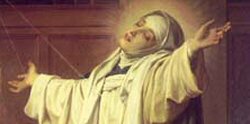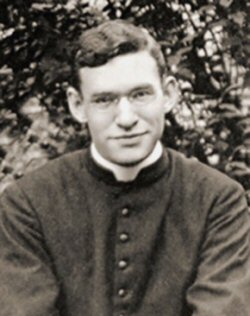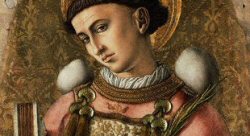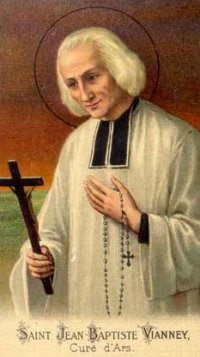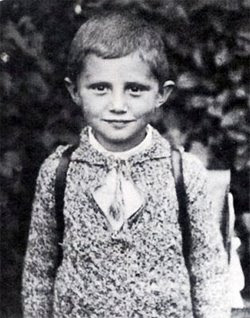If you are actively discerning a vocation to the Priesthood, Diaconate, Consecrated Life, or Marriage and you are looking for information to help in your discernment, BE SURE TO CHECK the section at the bottom of the right sidebar for the "labels" on all posts. By clicking on one of these labels it will take you to a page with all posts containing that subject. You will also find many links for suggested reading near the bottom of the right sidebar. Best wishes and be assured of my daily prayers for your discernment.

Wednesday, July 28, 2010
"Rays of Musical Light: Cloistered Nuns Share Record Label With Elton John"
From Catholic Online
By Sonja Corbitt
NASHVILLE, TN (Catholic Online) - "The whole world, compacted as it were together, was represented to [Benedict's] eyes in one ray of light" (The Life of Our Most Holy Father Saint Benedict, Pope Saint Gregory the Great).
It seems the cloistered, self-sufficient community of the Abbey of Our Lady of the Annunciation near Avignon, France, also sees the world through a Benedictine ray of light, and is about to diffuse a radiant love all over the world through the slow, soaring movements of their Gregorian chant.
Benedictine vows include Stability, Fidelity to the Monastic Life, and Obedience, and their communal life is centered around the eight canonical hours of the Divine Office. The Benedictine Divine Office is one of the most ancient daily observances of any kind anywhere in the world, and Gregorian chant is the oldest music ever written down.
Originating in the ancient Jewish prayer tradition, Benedictines continued the practice of daily singing of the psalms (meaning, songs) and have conducted the Divine Office for the 1500 years since St. Benedict first wrote and compiled his Rule. The Benedictine sisters at the Abbey of Our Lady of the Annunciation, following the Liturgy of the Hours, sing eight times a day.
Ora et Labora, Pray and Work
The mystery and poetry of Scripture at its earthly best, Benedictine prayer rolls on, as daily as parenting, washing dishes, and marriage. Its chant is a living, lived-in song, a relationship with God and Church revealed and expressed in ordinary, but sacred, words and music. It is benediction.
It is this blessing, this work of prayer at the Abbey of Our Lady of the Annunciation, France that attracted the attention of a talent scout for Decca Records. "When you hear them chanting, it's like an immediate escape from the stresses, noise and pace of modern living," he said of the prayer of Benedictine nuns cloistered there.
Decca Records is part of Universal Music, a British label which also produces albums by The Rolling Stones, Lady Gaga, Eminem, Amy Winehouse, U2 and Elton John. After chant first gained secular popularity through Enigma's chart successes in the 1990s, and the last Gregorian chant album released sold over a million albums, Decca Records went on a worldwide search for the finest female Gregorian chanters.
Their anxious ears finally came to rest on the lilting prayer of the Benedictine sisters in Avignon who were chosen over more than 70 other convents worldwide. Typically, prospective pop stars cannot garner enough publicity, but this group is slightly different.
Hidden Life
"We never sought this, it came looking for us," said the abbey's Reverend Mother in a statement released by Universal Music, and indeed, their seclusion posed some challenges for both the record label and the religious community.
"Before starting the recording we were a bit nervous," said English speaking Sister Raphael in an interview. She expressed the whole community's concern for the extraordinary project:
"We were a bit afraid of what was going to happen to our cloistered life, so we confided this to St. Joseph in our prayer: that if this was going to help people to pray, if it was going to help people find God, if it's going to help people find peace, [he should] make this go through."
And "go through" it did, presumably under his patronage and special protection. In accordance with St. Joseph's lifelong, heroic protection of the consecrated, Decca took exceptional measures to protect the isolation the nuns vow until death.
The album contract was passed to the sisters for their signature through the beautiful wood-worked partition that secludes them from the outside world, and recording engineers were only allowed into the convent when the nuns were in different parts of the abbey.
After setting up microphones in the chapel, they retreated to a separate room when the sisters sang, remotely directing the recording. To promote the album, the sisters filmed their own television commercial and photographed the album cover.
"We had to give the cameras to the nuns, because they had access to the more beautiful parts of the monastery," a Decca spokesperson remembered fondly, "so we had to actually hand everything over to them. And they were making their own TV advert, they were making their own CD cover, and it was a very interesting and different way of working."
A Ray of Musical Light
They have no access to newspapers, TV or radio, but the sisters are now on Facebook and YouTube, and their album, Voice: Chant from Avignon, will be released early this November. Remarkably, although the nuns never leave the convent, the whole world will feel the radiant peace of their singing.
"I think that our music appeals to a wider audience, secular and non-secular. The words have a very profound meaning that is coming from the Sacred Scripture. The singing in our daily lives is very important for us. It is our prayer," said Sister Raphael, conveying the heart of her community. It has been said that other than the Bible, the Benedictine Rule was the most influential book in the development of western civilization, a light in medieval darkness.
"It's not quite a question of how we feel when we sing, but who we are, and for whom we sing," the sisters confirm. Indeed, the chanted Office is a song of Love, and they consider this song as one way to contemplatively bring sacred, musical, Benedictine light to a dark, frantic, noisy world.
Monday, July 26, 2010
N.C. Prep School has third alumnus accepted as seminarian

 From the St. Thomas More Academy website:
From the St. Thomas More Academy website:Photos at left: Jonathon Baggett (far left), Michael Schuetz.
Raleigh, NC, July 2, 2010 / St. Thomas More Academy (STMA) congratulates John Kane (Class of ‘07) on being accepted as a seminarian for the Diocese of Raleigh. He joins fellow alumni Jonathon Baggett (‘07) and Michael Schuetz (‘08) as the third graduate from STMA in formation for the Diocesan Priesthood at St. Charles Borromeo Seminary in Philadelphia.
Kane began discerning his vocation while at STMA and continued to discern during subsequent years at Belmont Abbey College, near Charlotte. He related that it was friends at STMA who helped him grow in his faith and begin to take it much more seriously. He said that the faculty provided a solid Catholic environment where he was able to begin discerning the call to become a priest.
Jonathon Baggett, STMA’s first seminarian, when asked about the role St. Thomas More Academy played in his formation and discernment of a vocation, had the following to say: “St. Thomas More Academy was a major contributor to my discernment. It was the only place outside of youth group where I knew peers who were excited about Catholicism. These experiences solidified for me the reality of our faith and inspired me to want to live that faith out radically.”
Baggett added “STMA also prepared me academically for my studies at the seminary. Having studied philosophy and Latin really put me ahead of the learning curve at St. Charles Borromeo.”
Michael Schuetz related: “My time at STMA gave me the opportunity to grow in my faith and to realize that it was ‘cool’ to be Catholic. This open Catholic environment allowed me to explore my faith and enabled me to begin my discernment. I know that no matter where God is ultimately calling me in life, the time I spent at STMA helped me to grow and mature, giving me the beginning formation that would, God Willing, help me become a man of God.”
Schuetz continued, “Looking back at my education at STMA I realized that my teachers’ main goal was to prepare me for college. The education I received in high school gives me comfort in college, because I had previously seen these materials and I knew something about the subjects we are covering.”
Of the sixty-five graduates of St. Thomas More Academy, three alumni, roughly 10% of the male graduates, are now studying for the priesthood – a remarkable percentage for any institution in the Church today.
We are extremely proud of all our graduates, and very pleased to count these three fine young men among them. They have said “Yes!” to Our Lord’s call and have offered their lives in service to the People of God in the Diocese of Raleigh. In doing so, they stand as wonderful examples of generous and faithful individuals, attributes that STMA students and alumni have come to embody.
Please continue to pray for these young men and for the other young men and women from STMA who are in the discernment process. AMDG+
Saturday, July 24, 2010
"23 Reasons Why A Priest Should Wear His Collar"
 From Homiletics and Pastoral Review
From Homiletics and Pastoral ReviewBy Msgr. Charles M. Mangan & Father Gerald E. Murray
Photo at left: Pope John Paul II after his ordination to the Priesthood
Photo at left: Pope John Paul II after his ordination to the Priesthood
1. The Roman collar is a sign of priestly consecration to the Lord. As a wedding ring distinguishes husband and wife and symbolizes the union they enjoy, so the Roman collar identifies bishops and priests (and often deacons and seminarians) and manifests their proximity to the Divine Master by virtue of their free consent to the ordained ministry to which they have been (or may be) called.
2. By wearing clerical clothing and not possessing excess clothes, the priest demonstrates adherence to the Lord’s example of material poverty. The priest does not choose his clothes – the Church has, thanks to her accumulated wisdom over the past two millennia. Humble acceptance of the Church’s desire that the priest wear the Roman collar illustrates a healthy submission to authority and conformity to the will of Christ as expressed through his Church.
3. Church Law requires clerics to wear clerical clothing. We have cited above number 66 of the Directory for priests, which itself quotes canon 284.
4. The wearing of the Roman collar is the repeated, ardent desire of Pope John Paul II. The Holy Father’s wish in this regard cannot be summarily dismissed; he speaks with a special charism. He frequently reminds priests of the value of wearing the Roman collar.In a September 8, 1982 letter to Ugo Cardinal Poletti, his Vicar for the Diocese of Rome, instructing him to promulgate norms concerning the use of the Roman collar and religious habit, the Pontiff observed that clerical dress is valuable “not only because it contributes to the propriety of the priest in his external behavior or in the exercise of his ministry, but above all because it gives evidence within the ecclesiastical community of the public witness that each priest is held to give of his own identity and special belonging to God.”In a homily on November 8, 1982 the Pope addressed a group of transitional deacons whom he was about to ordain to the priesthood. He said that if they tried to be just like everyone else in their “style of life” and “manner of dress,” then their mission as priests of Jesus Christ would not be fully realized.
5. The Roman collar prevents “mixed messages”; other people will recognize the priest’s intentions when he finds himself in what might appear to be compromising circumstances. Let’s suppose that a priest is required to make pastoral visits to different apartment houses in an area where drug dealing or prostitution is prevalent. The Roman collar sends a clear message to everyone that the priest has come to minister to the sick and needy in Christ’s name. Idle speculation might be triggered by a priest known to neighborhood residents visiting various apartment houses dressed as a layman.
5. The Roman collar prevents “mixed messages”; other people will recognize the priest’s intentions when he finds himself in what might appear to be compromising circumstances. Let’s suppose that a priest is required to make pastoral visits to different apartment houses in an area where drug dealing or prostitution is prevalent. The Roman collar sends a clear message to everyone that the priest has come to minister to the sick and needy in Christ’s name. Idle speculation might be triggered by a priest known to neighborhood residents visiting various apartment houses dressed as a layman.
6. The Roman collar inspires others to avoid immodesty in dress, words and actions and reminds them of the need for public decorum. A cheerful but diligent and serious priest can compel others to take stock of the manner in which they conduct themselves. The Roman collar serves as a necessary challenge to an age drowning in impurity, exhibited by suggestive dress, blasphemous speech and scandalous actions.
7. The Roman collar is a protection for one’s vocation when dealing with young, attractive women. A priest out of his collar (and, naturally, not wearing a wedding ring) can appear to be an attractive target for the affections of an unmarried woman looking for a husband, or for a married woman tempted to infidelity.
8. The Roman collar offers a kind of “safeguard “for oneself. The Roman collar provides a reminder to the priest himself of his mission and identity: to witness to Jesus Christ, the Great High Priest, as one of his brother-priests.
9. A priest in a Roman collar is an inspiration to others who think: “Here is a modern disciple of Jesus.” The Roman collar speaks of the possibility of making a sincere, lasting commitment to God. Believers of diverse ages, nationalities and temperaments will note the virtuous, other-centered life of the man who gladly and proudly wears the garb of a Catholic priest, and perhaps will realize that they too can consecrate themselves anew, or for the first time, to the loving Good Shepherd.
10. The Roman collar is a source of beneficial intrigue to non-Catholics. Most non- Catholics do not have experience with ministers who wear clerical garb. Therefore, Catholic priests by virtue of their dress can cause them to reflect – even if only a cursory fashion – on the Church and what she entails.
11. A priest dressed as the Church wants is a reminder of God and of the sacred. The prevailing secular morass is not kind to images which connote the Almighty, the Church, etc. When one wears the Roman collar, the hearts and minds of others are refreshingly raised to the “Higher Being” who is usually relegated to a tiny footnote in the agenda of contemporary culture.
12. The Roman collar is also a reminder to the priest that he is “never not a priest.” With so much confusion prevalent today, the Roman collar can help the priest avoid internal doubt as to who he is. Two wardrobes can easily lead – and often does – to two lifestyles, or even two personalities.
13. A priest in a Roman collar is a walking vocation message. The sight of a cheerful, happy priest confidently walking down the street can be a magnet drawing young men to consider the possibility that God is calling them to the priesthood. God does the calling; the priest is simply a visible sign God will use to draw men unto himself.
14. The Roman collar makes the priest available for the Sacraments, especially Confession and the Anointing of the Sick, and for crisis situations. Because the Roman collar gives instant recognition, priests who wear it make themselves more apt to be approached, particularly when seriously needed. The authors can testify to being asked for the Sacraments and summoned for assistance in airports, crowded cities and isolated villages because they were immediately recognized as Catholic priests.
15. The Roman collar is a sign that the priest is striving to become holy by living out his vocation always. It is a sacrifice to make oneself constantly available to souls by being publicly identifiable as a priest, but a sacrifice pleasing to Our Divine Lord. We are reminded of how the people came to him, and how he never turned them away. There are so many people who will benefit by our sacrifice of striving to be holy priests without interruption.
16. The Roman collar serves as a reminder to “alienated” Catholics not to forget their irregular situation and their responsibilities to the Lord. The priest is a witness – for good or ill – to Christ and his Holy Church. When a “fallen-away” sees a priest, he is encouraged to recall that the Church continues to exist. A cheerful priest provides a salutary reminder of the Church.
17. The wearing of clerical clothing is a sacrifice at times, especially in hot weather. The best mortifications are the ones we do not look for. Putting up with the discomforts of heat and humidity can be a wonderful reparation for our own sins, and a means of obtaining graces for our parishioners.
18. The Roman collar serves as a “sign of contradiction” to a world lost in sin and rebellion against the Creator. The Roman collar makes a powerful statement: the priest as an alter Christus has accepted the Redeemer’s mandate to take the Gospel into the public square, regardless of personal cost.
19. The Roman collar helps priests to avoid the on duty/off duty mentality of priestly service. The numbers 24 and 7 should be our special numbers: we are priests 24 hours a day, 7 days a week. We are priests, not men who engage in the “priest profession.” On or off duty, we should be available to whomever God may send our way. The “lost sheep” do not make appointments.
20. The “officers” in Christ’s army should be identifiable as such. Traditionally, we have remarked that those who receive the Sacrament of Confirmation become “soldiers” of Christ, adult Catholics ready and willing to defend his name and his Church. Those who are ordained as deacons, priests and bishops must also be prepared – whatever the stakes – to shepherd the flock of the Lord. Those priests who wear the Roman collar show forth their role unmistakably as leaders in the Church.
21. The saints have never approved of a lackadaisical approach concerning priestly vesture. For example, Saint Alphonsus Liguori (1696-1787), Patron Saint of Moral Theologians and Confessors, in his esteemed treatise The Dignity and Duties of the Priest, urges the wearing of the appropriate clerical dress, asserting that the Roman collar helps both priest and faithful to recall the sublime splendor of the sacerdotal state instituted by the God-Man.
22. Most Catholics expect their priests to dress accordingly. Priests have long provided a great measure of comfort and security to their people. As youths, Catholics are taught that the priest is God’s representative – someone they can trust. Hence, the People of God want to know who these representatives are and what they stand for. The cherished custom of wearing distinguishable dress has been for centuries sanctioned by the Church; it is not an arbitrary imposition. Catholics expect their priests to dress as priests and to behave in harmony with Church teaching and practice. As we have painfully observed over the last few years, the faithful are especially bothered and harmed when priests defy the legitimate authority of the Church, and teach and act in inappropriate and even sinful ways.
23. Your life is not your own; you belong to God in a special way, you are sent out to serve him with your life. When we wake each morning, we should turn our thoughts to our loving God, and ask for the grace to serve him well that day. We remind ourselves of our status as His chosen servants by putting on the attire that proclaims for all to see that God is still working in this world through the ministry of poor and sinful men.
Msgr. Charles M. Mangan & Father Gerald E. Murray. “Why a priest should wear his Roman collar.” Homiletic & Pastoral Review (June, 1995).
Founded over one hundred years ago, Homiletic & Pastoral Review is one of the most well-respected pastoral magazines in the world. HPR features solid articles on every aspect of pastoral life and eloquent weekly sermons that illuminate through exposition of Scripture. Subscribe to HPR here.
THE AUTHORS
Msgr. Charles M. Mangan has been appointed by His Holiness, Pope John Paul II, to a position serving the Vatican’s Congregation for Institutes of Consecrated Life and Societies of Apostolic Life. Ordained in 1989, Msgr. Mangan formerly served the Diocese of Sioux Falls in several parishes.
Father Gerald E. Murray is a priest of the Archdiocese of New York. He is a graduate of Dartmouth College and was ordained in 1984 after completing studies at St. Joseph’s Seminary in Dunwoodie, N. Y. Currently he is studying canon law at the Gregorian University in Rome.
Msgr. Charles M. Mangan & Father Gerald E. Murray. “Why a priest should wear his Roman collar.” Homiletic & Pastoral Review (June, 1995).
Founded over one hundred years ago, Homiletic & Pastoral Review is one of the most well-respected pastoral magazines in the world. HPR features solid articles on every aspect of pastoral life and eloquent weekly sermons that illuminate through exposition of Scripture. Subscribe to HPR here.
THE AUTHORS
Msgr. Charles M. Mangan has been appointed by His Holiness, Pope John Paul II, to a position serving the Vatican’s Congregation for Institutes of Consecrated Life and Societies of Apostolic Life. Ordained in 1989, Msgr. Mangan formerly served the Diocese of Sioux Falls in several parishes.
Father Gerald E. Murray is a priest of the Archdiocese of New York. He is a graduate of Dartmouth College and was ordained in 1984 after completing studies at St. Joseph’s Seminary in Dunwoodie, N. Y. Currently he is studying canon law at the Gregorian University in Rome.
Tuesday, July 20, 2010
"From the pub to the convent: sisters seek new vocations in changing world"
 From Catholic News Agency
From Catholic News AgencyRome, Italy, Jul 19, 2010 / 07:21 pm (CNA).- A summer course for religious sisters began on Monday at one of Rome's Pontifical Colleges which examines the approach of religious congregations to attracting interest for new vocations. The course takes a look at vocational pastoral ministry in a changing world.
The official program for the July 19-24 "Animation Vocation"course promotes it as "a week of prayer, listening, exchange of international experiences, proposals for new strategies and planning."
Included among the variety of attention grabbing sessions within the six days of the course at the Pontifical Atheneum Regina Apostolorum University are titles such as "From the internet to the convent" and "Vocation promoters among cosmetics and pubs." Of the latter, Italian media in recent days have run a variety of headlines, perhaps topped by Italian news agency TGCOM's "Sisters, between whiskey and make-up."
CNA spoke with a spokesperson of the University's Institute of Religious Studies, Dr. Laura Salvo, about the idea behind the course, which has drawn 100 religious sisters from more than 30 congregations worldwide.
She said that it takes a look at how congregations can get in touch with youth, adapting their vocational ministry to the contemporary world by meeting potential candidates on their playing field.
Dr. Salvo noted that they are making an effort to understand the "language" of the younger generation, transmitting values while recognizing the changes that have taken place. The modified approach, she said, "doesn't change values just the modality."
Changing the approach is important, she emphasized, especially in more developed nations where there are more distractions. She explained that "We're living a much stronger crisis in vocations (in Italy) than in other places" where the "consumerist" culture isn't as widespread and faith is "more at the center" of people's lives.
The official communique for the course promotes the returned enthusiasm to the consecrated life as "crucial" to the third millennium, describing the religious sister as "the bearer of the most characteristic values of human nature."
The official program for the July 19-24 "Animation Vocation"course promotes it as "a week of prayer, listening, exchange of international experiences, proposals for new strategies and planning."
Included among the variety of attention grabbing sessions within the six days of the course at the Pontifical Atheneum Regina Apostolorum University are titles such as "From the internet to the convent" and "Vocation promoters among cosmetics and pubs." Of the latter, Italian media in recent days have run a variety of headlines, perhaps topped by Italian news agency TGCOM's "Sisters, between whiskey and make-up."
CNA spoke with a spokesperson of the University's Institute of Religious Studies, Dr. Laura Salvo, about the idea behind the course, which has drawn 100 religious sisters from more than 30 congregations worldwide.
She said that it takes a look at how congregations can get in touch with youth, adapting their vocational ministry to the contemporary world by meeting potential candidates on their playing field.
Dr. Salvo noted that they are making an effort to understand the "language" of the younger generation, transmitting values while recognizing the changes that have taken place. The modified approach, she said, "doesn't change values just the modality."
Changing the approach is important, she emphasized, especially in more developed nations where there are more distractions. She explained that "We're living a much stronger crisis in vocations (in Italy) than in other places" where the "consumerist" culture isn't as widespread and faith is "more at the center" of people's lives.
The official communique for the course promotes the returned enthusiasm to the consecrated life as "crucial" to the third millennium, describing the religious sister as "the bearer of the most characteristic values of human nature."
"More than 1,300 teens studying in minor seminaries in Spain"
From the Catholic News Agency
Madrid, Spain, Jul 19, 2010 / 06:03 pm (CNA).- The Spanish daily La Razon reported this week that more than 1,300 teens between the ages of 12 and 18 are currently pursing a call to the priesthood by studying at the 53 diocesan minor seminaries that exist in the country.
An article written by Alex Navajas revealed that while “some kids at that age dream about being soccer players, business leaders, doctors or bullfighters,” others, “as soon as they enter adolescence, want to become priests.”
Such is the case with Alvaro Pinero, a 16-year-old from Toledo, who entered the minor seminary school in Madrid in 2006. He discovered his vocation at the age of 12 but felt unsure. “The school helped me a lot. It’s a great environment where we have good friendships and my classmates feel like they are my second family,” he said.
Another student, Adrian, felt the call to the priesthood at the age of five as an altar boy in his hometown of Monturque. At the age of 12 he entered the seminary of San Pelegio, and now at age 16 he says of the seminary, “Our ideal is Christ. Prayer is part of our formation, because without it we can do nothing. Our spiritual retreats are times of more intense prayer in order know and love Christ more.”
Santiago Fernandez, 18, has been in the minor seminary for two years and in September he will graduate to major seminary. “At first, my friends reacted very negatively. Then, when they saw how well I was doing, they began to support me,” he recalled.
Bishop Demetrio Fernandez of Cordoba also discovered his vocation at an early age and attended minor seminary. “I wanted to be a priest since I was seven,” he said. “I was an altar boy and I told my pastor, who was a key part of my vocation.” He said the years at minor seminary “were the happiest of my life. I only have positive things to say about minor seminaries,” Bishop Fernandez added.
Bishop Fernandez is one among many Spanish bishops who attended minor seminary, including the Archbishop of Toledo and the Bishop of Jaen. According to Antonio Prieto, the rector of the minor seminary of Cordoba, “more than 60 percent of the clergy of our diocese has passed through these halls.”
Madrid, Spain, Jul 19, 2010 / 06:03 pm (CNA).- The Spanish daily La Razon reported this week that more than 1,300 teens between the ages of 12 and 18 are currently pursing a call to the priesthood by studying at the 53 diocesan minor seminaries that exist in the country.
An article written by Alex Navajas revealed that while “some kids at that age dream about being soccer players, business leaders, doctors or bullfighters,” others, “as soon as they enter adolescence, want to become priests.”
Such is the case with Alvaro Pinero, a 16-year-old from Toledo, who entered the minor seminary school in Madrid in 2006. He discovered his vocation at the age of 12 but felt unsure. “The school helped me a lot. It’s a great environment where we have good friendships and my classmates feel like they are my second family,” he said.
Another student, Adrian, felt the call to the priesthood at the age of five as an altar boy in his hometown of Monturque. At the age of 12 he entered the seminary of San Pelegio, and now at age 16 he says of the seminary, “Our ideal is Christ. Prayer is part of our formation, because without it we can do nothing. Our spiritual retreats are times of more intense prayer in order know and love Christ more.”
Santiago Fernandez, 18, has been in the minor seminary for two years and in September he will graduate to major seminary. “At first, my friends reacted very negatively. Then, when they saw how well I was doing, they began to support me,” he recalled.
Bishop Demetrio Fernandez of Cordoba also discovered his vocation at an early age and attended minor seminary. “I wanted to be a priest since I was seven,” he said. “I was an altar boy and I told my pastor, who was a key part of my vocation.” He said the years at minor seminary “were the happiest of my life. I only have positive things to say about minor seminaries,” Bishop Fernandez added.
Bishop Fernandez is one among many Spanish bishops who attended minor seminary, including the Archbishop of Toledo and the Bishop of Jaen. According to Antonio Prieto, the rector of the minor seminary of Cordoba, “more than 60 percent of the clergy of our diocese has passed through these halls.”
Monday, July 19, 2010
Subscribe to:
Posts (Atom)







